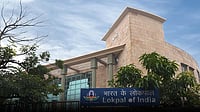As the Chandrayaan-3 enters the final leg of its 14-day mission, the Indian Space Research Organisation (ISRO) on Friday said the focus is on collecting as much data as possible and attempts are being made to move the rover more in the remaining two days that has only moved around 65-70 metres so far.
The Chandrayaan-3 mission comprising Vikram lander and Pragyaan rover had a mission-span of 14-Earth days. The rover emerged out of the lander within hours of landing on Moon's South Pole on August 23. As Chandrayaan-3 touched down on Moon, India became the first country ever to land a spacecraft on Moon and fourth country overall to land on Moon.
The Vikram lander and Pragyaan rover have six instruments that are conducting a range of experiments, such as understanding the Lunar soil, studying its temperature, understanding siesmic activity there, etc. So far, the highlights of the findings have been the variation in Moon's temperature; confirmation of elements like oxygen, sulphur, calcium, iron, etc; and detecting earthquake-like siesmic activities.
While insights gathered by Chandrayaan-3 are set to be studied keenly by all the agencies, the movement of Pragyaan has been far from expectations. Compared to 300-350 metres that was expected, the rover has only moved 65-70 metres, said Nilesh M Desai, Director of ISRO's Space Applications Centre (SAC).
Desai told ANI, "We have moved around 65-70 metres. Our initial expectation was that we would move it around 30 metres a day. It moves five metres in one go and we wanted to move it six time a day. We have not been able to do it."
Desaid explained that the rover can only be moved after proper "path-planning" and initial issues happened as an earth station was not available for such planning, which is still not available.
Desai also said that they are "in a race against time" as the mission is scheduled to conclude on September 3 evening and the focus is on collecting as much data as possible until then, which can later be analysed on Earth.
Explaining the scientific activities so far, Desai said, "We have discovered temperature varation from minus 10 degrees to plus 50 degrees. From Laser Retroreflector Array, we are corroborating the changes in Moon's distance from Earth from the South Pole. We already know that Moon is moving away from Earth by around 1.8 inches a year. The siesmic sensor will confirm if there moonquakes like earthquakes."
While the mission of Chandrayaan-3 is set to last only for 14 days, the information collected during these two weeks could benefit the understanding of Moon greatly. The South Pole of Moon is of great interest as this is a shadowy and unexplored region of the Moon where ice is known to exist and there is a possibility that water could be there as well. Earlier in 2009, a US-made instrument aboard Chandrayaan-1 had confirmed the presence of ice on Moon's South Pole.
The potential presence of water on South Pole of Moon is a major cause of excitement. India is set to follow Chandrayaan-3 with a joint mission to search water on the Moon with Japan's space agency. The mission called LUPEX is set to be launched in 2025 which would look for water on Moon's both polar regions.
The presence of water would be key to any longterm human presence on Moon. Under the Artemis Programme of the United States, Moon is set to be the stepping stone to Mars and beyond and not the destination in itself. In 2025-26, the US space agency NASA is set to land humans on Moon for the first time in five decades under the Artemis-III mission.


























